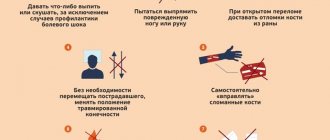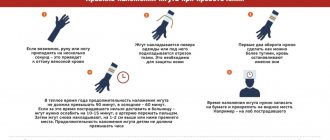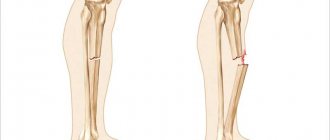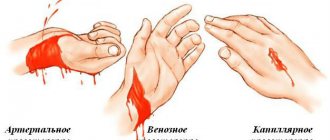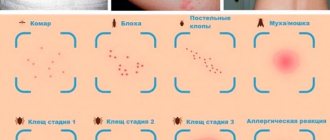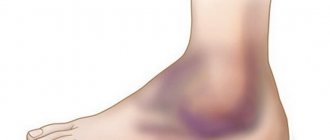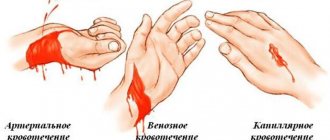A fracture is a bone injury that disrupts its integrity. Traumatic fractures are divided into open (there is damage to the skin in the fracture area) and closed (the skin is not broken).
With an open fracture, the injury is beyond doubt. A closed fracture is not so obvious, especially if it is incomplete, when part of the diameter of the bone is broken, often in the form of a crack.
All fractures are characterized by:
- sharp pain with any movements and loads;
- change in the position and shape of the limb, its shortening;
- dysfunction of a limb (impossibility of usual actions or abnormal mobility);
- swelling and bruising in the fracture area.
Providing first aid for fractures of the extremities largely determines the outcome of the injury: the speed of healing, the prevention of a number of complications (bleeding, displacement of fragments, shock) and has three goals:
- creating immobility of bones in the fracture area (which prevents displacement of fragments and damage to them by the edges of blood vessels, nerves and muscles);
- prevention of shock;
- prompt delivery of the victim to a medical facility.
General classification of fractures and their characteristic features
The general classification of fractures is usually based on the degree of rupture (damage) to the bone. First of all, a distinction is made between complete and incomplete fractures, as well as open and closed, with and without displacement of bone fragments. It wouldn’t hurt to immediately voice the general signs on the basis of which a person is preliminarily diagnosed with a fracture:
- an arm, leg, spine or pelvis is deformed;
- severe pain in the damaged area;
- the position of the limb looks unnatural;
- hemorrhages and swelling are observed.
The main actions in such a situation are, if possible, to restore the integrity of the bone, stop the bleeding, if any, treat the wound with an antiseptic, immobilize the damaged limb and transport the patient to the trauma department of the hospital on an emergency basis.
Arm fractures: what should be done and what should not be done?
The most important point is to immobilize the broken limb as quickly as possible so that a closed fracture does not become an open one. To immobilize the arms, it is customary to use splints, fixing them to the limb in a certain way. If a real tire is not at hand, you can use improvised materials - for example, a thick tree branch, plywood, boards, etc. In case of severe pain, the victim should be given a painkiller. The arm with the splint should be bent at the elbow and suspended, and in order to prevent the development of pain shock, the patient is warmed in all possible ways, from hot tea to blankets or heating pads.
If the patient has an open fracture, the main task is to stop the bleeding by applying a tourniquet above the wound surface. The time for applying a tourniquet should be no more than 30, maximum 40 minutes, otherwise necrosis of the limb may develop, since it practically does not receive blood flow. If there is no tourniquet nearby, any available means in the form of a piece of torn fabric, rope, or belt will do instead.
To prevent infection, the wound is treated with an antiseptic. It is unacceptable to pull the patient’s injured limb in an attempt to straighten the bone.
First aid for bruises
During a fall or impact, soft tissues or organs of a person are damaged, this is called a bruise. In case of bruises of the joints , bruises of the leg, arm, visible violations of the integrity of the joints or skin are usually not observed. With bruises, tissue swelling may begin or a hematoma may appear. As damage progresses, pain increases and limb mobility is impaired.
What to do if you have bruises? To provide first aid for bruises, apply cold to the damaged surface. This could be cold water, a bottle, or a hot water bottle with ice. But when providing assistance for bruises, do not forget to prevent hypothermia. The cold should be applied for no more than 15 minutes, then the ice should be removed for 5 minutes and if the pain does not subside, then the cold should be applied for another 15 minutes.
Leg fractures: what should be done, what actions are unacceptable?
Fractures of the lower extremities are accompanied by:
- impairment of their mobility;
- acute pain;
- open bleeding (if large arteries are damaged as a result of an open fracture);
- closed bleeding (inside the tissues, if we are talking about a closed fracture).
Nerves may also be affected, causing the limb to lose its former sensitivity.
The first thing to do when a leg is broken is to fix it using available means (board, long tree branch, ski pole). As in the case of a fracture of the upper limb, if it is open and accompanied by severe bleeding, a tourniquet is applied to the leg above the affected area. For severe pain, the patient is given analgesics.
If possible, the limb is immobilized using a Dieterichs splint. These are boards with drilled holes. By connecting them together, you can completely immobilize your leg.
Self-reduction of the bone at the scene of the accident is unacceptable.
Prices for services
- Removing the plaster cast (splint) 660a
- Treatment of open fracture site 825a
- Removing the cellocast bandage 860a
- Application of an immobilization bandage for bone fractures 1320a
- Strengthening and correction of plaster, cellocast, turbocast bandages 1320a
- Application of a Turbocast (Orthosis) bandage without the cost of material 1320a
- Application of an immobilization bandage for spinal fractures 1760a
- Application of a small plaster cast (for injuries of the hand and foot) 2200a
- Closed manual reduction for fractures of small tubular bones 2640a
- Application of a medium plaster cast (for injuries to the bones of the forearm, radial joint) 3520a
- Application of a small cellocast bandage (for injuries of the hand and foot) 3850a
- Closed manual reduction for long bone fractures 4620a
- Application of a large plaster cast (for injuries of the shoulder, shoulder joint, knee joint) 5280a
- Application of a Turbocast bandage (Orthosis) for hand injuries 5390a
- Application of a medium cellocast bandage (for injuries of the forearm, lower leg) 6050a
- Application of a Turbocast bandage (Orthosis) for foot injuries 6160a
- Application of a large cellocast bandage (for injuries of the shoulder, knee joint) 7700a
- Application of a Turbocast bandage (Orthosis) on the wrist 14190a
- Application of a Turbocast bandage (Orthosis) to the ankle joint 19690a
- Application of a Turbocast bandage (Orthosis) to the elbow joint, knee joint 21890a
- Primary appointment (examination, consultation) with a traumatologist-orthopedist 1210a
The information and prices presented on the website are for reference only and do not constitute a public offer.
What can and cannot be done for spinal fractures
This is one of the most severe and complex types of fracture, threatening the patient’s life. First aid must be provided competently and correctly, with the body held still and painkillers taken. Even if the damage to the spine, at first glance, looks insignificant, it can lead to disability of the victim. In such cases, people's ability to move is often completely or partially lost.
Why is such a fracture dangerous? First of all, damage to the spinal cord from bone fragments. If fragments of broken bones touch nerve fibers or blood vessels, this can lead to complete loss of both sensory and motor functions.
Symptoms for spinal column fractures usually look like this:
- the fracture area is very painful;
- the patient often loses consciousness and his blood pressure drops;
- if the cervical spine is broken, the head takes an unnatural position, and breathing functions are severely impaired. Unfortunately, in the vast majority of cases, people do not survive such a fracture, and death occurs instantly;
- if the lower back is injured, the legs cannot move. Involuntary urination often occurs.
Anesthesia and immobilization are the first things to do if the victim has signs of a spinal fracture. It is advisable for the patient to be on a hard, horizontal surface. For the purpose of immobilization, available means in the form of a board, door or large sheet of plywood are suitable. The head is fixed with a rigid “collar”, using soft cloth or cotton wool, if available.
Realignment of the spine is unacceptable, as are attempts to sit the victim down and, moreover, put him on his feet.
Fracture treatment
In a hospital or other medical institution, an x-ray is taken, with the help of which the diagnosis, location, nature of the damage and the direction of displacement of bone fragments are clarified.
Then the doctor sets the bone fragments (repositions them). This is done only after pain relief. If the fracture is not clearly visible, an incision may be made in the patient's skin. The injury site is secured with plaster or other medical device.
In case of severe injuries, surgical treatment of the fracture is performed; bone fragments are secured using plates, nails and screws. The fracture site is then fixed (immobilized) to ensure proper fusion of the bones.
In some cases, bone traction is required. In this case, a steel pin is attached to the bone below the site of injury, and a weight is attached to the two ends of the pin.
It should be noted that the rate of bone healing depends on the patient’s age, type of fracture, degree of bone mineralization and the presence of concomitant diseases.
Currently, modern devices such as the Ilizarov apparatus and orthosis .
1 Treatment of fractures
2 Treatment of fractures
3 Treatment of fractures
Treatment of fractures using the Ilizarov apparatus
The Ilizarov apparatus is used to reliably connect bone fragments in open and comminuted complex fractures. The spokes passing through the bones of the damaged limbs are attached to rings, which are secured with special transition elements. If necessary, this allows you to compress or stretch certain areas of the bone.
Using this design, you can not only fix a fracture, but also influence the rate of bone fusion. In addition, the Ilizarov apparatus allows you to move with a broken leg.
The process of installing and removing the Ilizarov apparatus
Installation of the device is carried out under local or general anesthesia. Two wires are passed over the fracture through parts of the bones perpendicular to each other. And the ends of the spokes are secured to the bone using clamps. The entire time the design is worn, it is necessary to properly care for it and wipe the knitting needles with a disinfectant solution.
Removal of the Ilizarov apparatus, as a rule, is carried out in the same clinic where the installation took place, or any other medical institution in which the corresponding traumatologist works. Removal of the Ilizarov apparatus is carried out using anesthesia.
Treatment of joint and bone diseases using an orthosis
An orthosis includes several types of orthopedic devices that are used to treat joints. These can be corsets, bandages, orthopedic shoes, as well as orthopedic insoles.
Orthoses can be used in the following cases:
- fixation and unloading of the spine and joints;
- restoration of musculoskeletal function after various injuries (used to treat fractures, dislocations, sprains and bruises);
- correction of deformities of the musculoskeletal system (kyphosis, scoliosis);
- pain relief from arthritis, arthrosis, osteochondrosis, etc.;
- protection of the spine and joints during increased physical activity.
But most often, an orthosis comes to the rescue in cases where it is necessary to fix a damaged joint.
Types of orthoses
According to their purpose, orthoses can be divided into 3 large groups:
- orthoses for the joints of the lower extremities (ankle orthosis, knee orthosis, hip joint device, orthopedic shoes and insoles);
- orthoses for the joints of the upper extremities (shoulder brace (scarf or orthosis), wrist orthosis, finger braces and elbow pads);
- orthosis for the spine (postpartum and prenatal bandages, collar splints, corsets).
Orthoses come in soft , rigid , semi-rigid and splint types . Most often, the degree of rigidity determines its purpose. For example, a soft ankle orthosis (or knee orthosis) resembles a bandage that is used to prevent joint diseases.
The rigid device is somewhat similar to plaster; it is a rather complex structure made of plastic and metal inserts. Prescribed for injuries, fractures, after surgery, for dislocations, when it is necessary to immobilize the joint.
The splint is used to restore an arm or leg after surgery or injury. The splint differs from an orthosis in that it has a different design, in which there are no hinges.
1 Treatment of fractures
2 Treatment of fractures
3 Treatment of fractures
What can and cannot be done for pelvic bone fractures
Like spinal fractures, injuries to the pelvic bones are classified as severe clinical cases. There are a lot of complications with them: disability, internal bleeding with a state of shock.
Typical symptoms of pelvic fractures include:
- severe pain in the bones, groin, stomach;
- bruises are found in the perineal area;
- an external examination often reveals deformation of the pelvic bones;
- if severe bleeding occurs, the pressure drops sharply, and a state of shock develops;
- The patient’s posture is forced, reminiscent of the position of the body of a frog: the knees are bent.
The basic principles of first aid are immobilization in the same position with fixation of the pelvic bones using any dressings, including improvised ones. A cushion is placed under the bent knees. It is strictly prohibited to put the victim on his feet or sit him down.
Our clinics in St. Petersburg
Structural subdivision of Polikarpov Alley Polikarpov 6k2 Primorsky district
- Pionerskaya
- Specific
- Commandant's
Structural subdivision of Zhukov Marshal Zhukov Ave. 28k2 Kirovsky district
- Avtovo
- Avenue of Veterans
- Leninsky Prospekt
Structural subdivision Devyatkino Okhtinskaya alley 18 Vsevolozhsk district
- Devyatkino
- Civil Prospect
- Academic
For detailed information and to make an appointment, you can call +7 (812) 640-55-25
Make an appointment
An open fracture is a type of fracture in which damage to the skin or mucous membranes occurs. Open fractures of the extremities are more common. The main danger of open fractures is that various microorganisms penetrate through the wound, which can infect soft tissues, bone fragments and cause such serious complications as wound suppuration, osteomyelitis and even tetanus.
